A Tale of Two Kingdoms Deluxe Edition Review
For the player who yearns for a return to the “golden age” of adventure gaming, this updated edition remains much the same as the original release in 2007







In July of 2007, Crystal Shards released A Tale of Two Kingdoms. At that time, it was described as a fantasy adventure in the style of classic Sierra games such as the early Kings Quest titles. The game was available for free and was very well received by the gaming community. JA’s own William Hughes delivered his review and gave it high marks in all areas.
Ten years pass… In late 2017, A Tale of Two Kingdoms is re-released for purchase on Steam as a Deluxe Edition that features a new interactive prologue, graphic updates, and professional voice acting. I believe that the music may also have been enhanced because the soundtrack is now available for purchase. The story, however, remains virtually unchanged from the original version and one can use a legacy walkthrough if assistance is needed with the Deluxe Edition.
Our story centers around two kingdoms, Qualinem and Theylinn. After many years of war, King Vortigern of Theylinn was defeated by Qualimen. Three years later, both kingdoms must come together to defeat a common enemy – an invading army of Goblins. Three heroes from Qalinem – Lady Branwyn, Taliesin, and Maeldun Whiteblade – are sent as envoys to meet with King Vortigern to strategize. During their visit, the king is assassinated and Maeldun is framed for the murder.
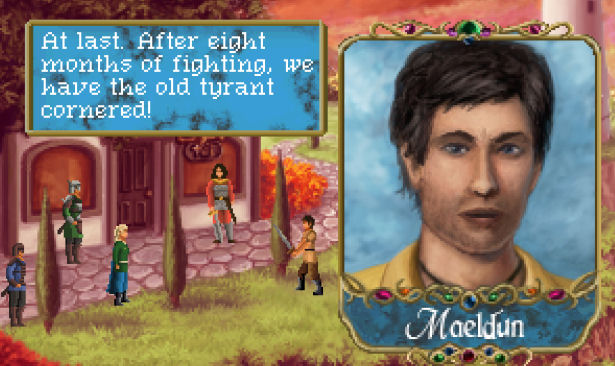
Maeldun escapes imprisonment and sets out on the game’s primary quest – to clear his name by identifying the real killer. And so begins a multi-chapter trek through the Two Kingdoms which exist in the world of Celtic mythology and fantasy. The lands are shared by humans, faeries, sorcerers, goblins, etc. Magic abounds.
There is a great deal of territory to explore in The Two Kingdoms and a lot of characters to interact with. Sub-quests are the order of the day, as most characters you meet have a favor to ask or an errand for you to run. The game is non-linear in that you are not forced along a certain path. You are free to explore and drive Maeldun’s progress in any way you choose. Thus, it is unlikely that any two players will experience the Two Kingdoms in the same way.
In an interesting departure from tradition, Maeldun accumulates honor and wisdom points as he performs deeds that are noble or clever. It should be noted that points can be lost by doing something ignoble. In the end, the paths you have walked and the honor/wisdom you have demonstrated drive which of the multiple game endings you will experience.
A Tale of Two Kingdoms is played from a 3rd person perspective, guiding Maeldun on his way. There is an emphasis on inventory, exploration, and dialog. All-in-all, it is a complex game world with much to do and much to learn. As one might expect from a game developed 10 years ago, the interface is primitive. And this is where, for me, the fun factor began to fade.
Moving the cursor to the top of the screen reveals a set of icons and provides access to your inventory. There are four action modes: walk, look, use, and speak. Your current mode can be selected from these icons or by right mouse-clicking to cycle through available modes. You can tell which mode you are in by the shape of the cursor (a walking man, an eye, a hand, or a mouth). When in walking mode, you click on the screen to move Maeldun to a selected spot. Since there is nothing on the screen to indicate exit points, you will need to move him around all edges of each scene to determine if an exit to the next scene exists. This results in a lot of clicking until you begin to build a mental map of the territory.

When you speak to a character, dialog topics are listed. When each topic is selected, the resulting conversation is displayed by flipping back and forth between cameos of Maeldun and the person he is speaking to. You can read and click through conversations or take the time to listen to the voice-acting (which is quite well done). In many cases, once a question is asked, it is no longer available as a topic. Thus, it behooves the player to pay close attention. In several cases, I did not listen carefully enough and then was unable to have the conversation again to gather the information I had missed.
You can also ask another character to “do something for you.” I found the mechanics of this function to be very confusing. The “do something” question gives you the option of controlling that character (albeit briefly) with a subset of the action icons. Using the eye or hand at the top of the screen, you can have him (or her) look at something or use something. You can also have the other character interact with your inventory. To move to the next topic, you must click on an ‘X’ icon at the top of the screen to exit the “do something” interface.
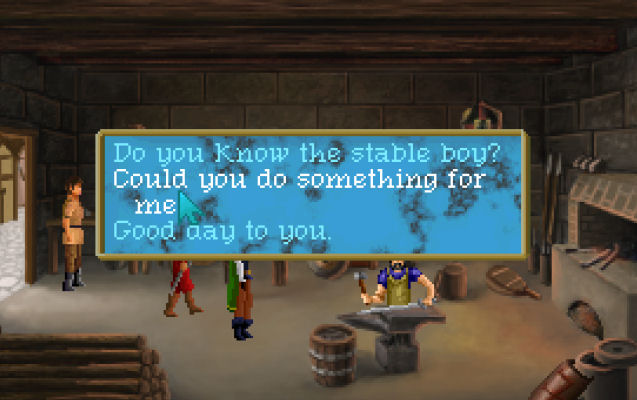
Inventory is accessed through an icon in the top left corner of the screen or by using the mouse wheel to cycle through objects. Inventory can be dragged and dropped to use in the environment or to give to another character. If you are using the mouse wheel, when a specific object appears as your cursor, it is immediately available for use. As part of inventory, there is a parchment icon that provides in-game note taking. Personally, I find that a pencil and paper are easier but the ability to jot down details as you play is a nice touch.
Be prepared for your inventory to grow at an alarming rate as you play through A Tale of Two Kingdoms. When it came to managing inventory, I never became accustomed to the low resolution. In many cases, inventory items were simply too pixelated to easily identify and I found myself using the “look” mode often to keep track of what I was carrying around. Case in point…is the item shown below in the lower right corner a hermit crab? A bag of gold? A bag of something else?
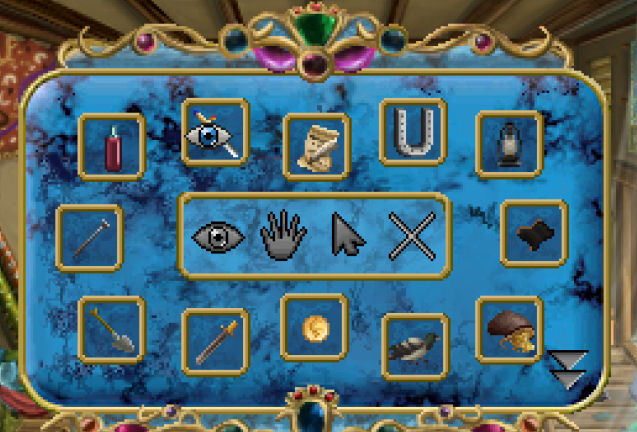
The main menu of A Tale of Two Kingdoms is accessed using the ESC key. Although the game does some autosaving, I found myself using the explicit save (with multiple save slots) constantly because there are so many ways to die. I drowned, was permanently imprisoned by goblins, was eaten by a magical beast, etc. When you die, it is game over. No “would you like to retry?”. You see a set of rhyming couplets describing your fate and then you start back at your chosen save point. I thought I’d be smart and save my game just before a fatal moment. To this, the game responded that “it was not a good time to save” and prevented me from doing so.
In many regards, A Tale of Two Kingdoms is a wonderful adventure game. It has a well-written story with plots and sub-plots. It has a large cast of characters, each with his/her own agenda. It has a host of “find and use” puzzles along the way and many choices to make. It allows players the freedom to control how they navigate through the environment, who they talk to, and what sub-quests they perform. My guess is that one could easily spend 30+ hours in the Two Kingdoms and not see and do everything. For the player who likes Celtic fantasy and yearns for a return to the “golden age” of adventure gaming, it is just about perfect.
For this adventurer, however, it was simply too much. Too much dialog, too many story threads, too many deaths, and too much wandering in a land that felt perpetually out of focus. Perhaps my gaming mindset has just changed over the last ten years. There are games I loved back then that are not necessarily ones I would choose to play today. If you do not want to step back in time or if you were not a fan of the Kings Quest-style “back in the day,” then you may want to skip this title.
|
+ Classic retro fantasy point-and-click adventure
+ Complex story and vast landscape provide many hours of play time
+ Non-linear game path makes each player’s experience unique
+ Excellent soundtrack with professional voice acting
– Pixelated graphics wear thin after many hours |
 |
Graphics: DirectX compatible card
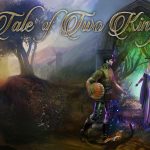
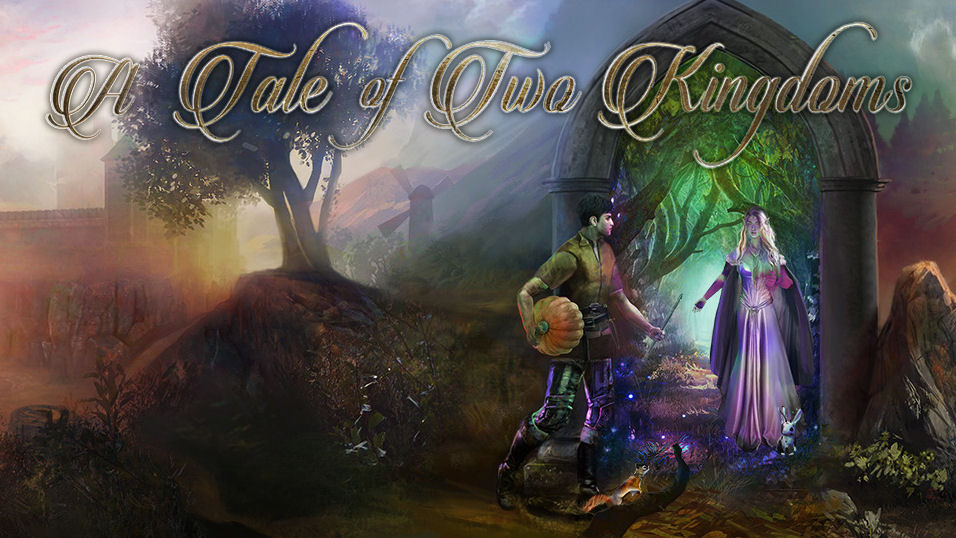
Leave a Reply